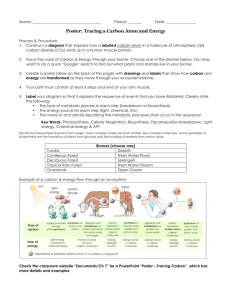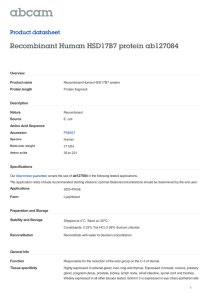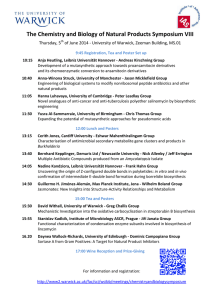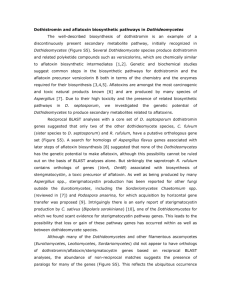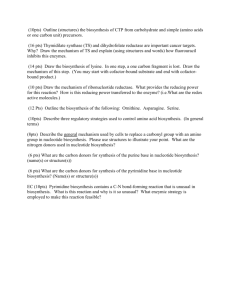Document 12812961
advertisement
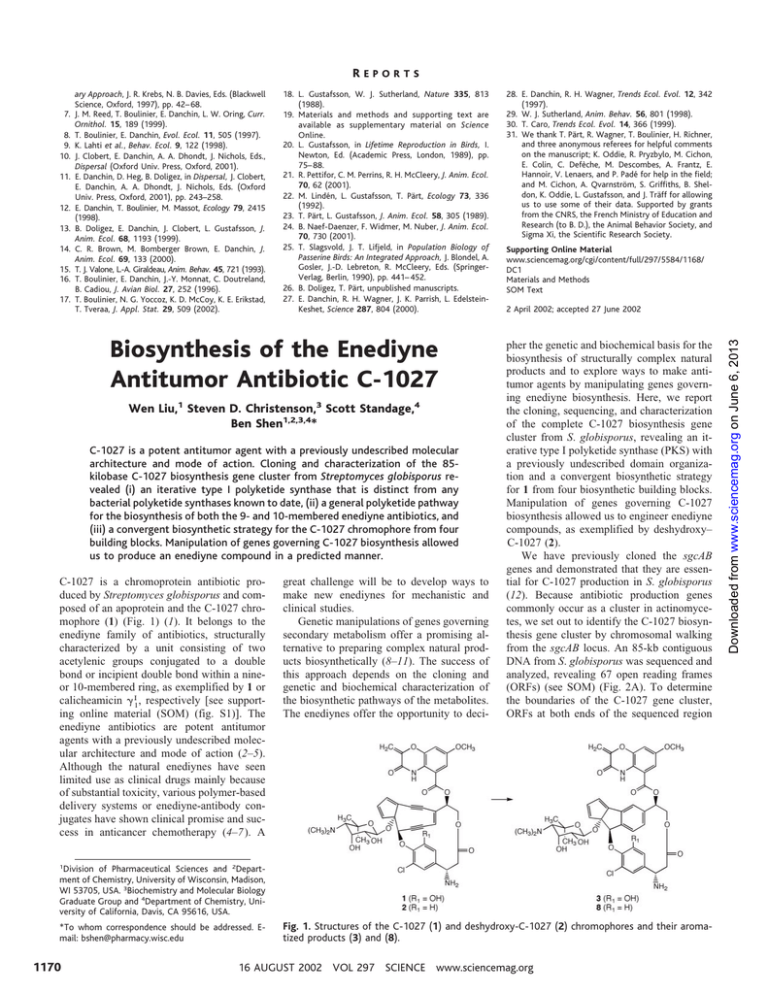
REPORTS 8. 9. 10. 11. 12. 13. 14. 15. 16. 17. 18. L. Gustafsson, W. J. Sutherland, Nature 335, 813 (1988). 19. Materials and methods and supporting text are available as supplementary material on Science Online. 20. L. Gustafsson, in Lifetime Reproduction in Birds, I. Newton, Ed. (Academic Press, London, 1989), pp. 75– 88. 21. R. Pettifor, C. M. Perrins, R. H. McCleery, J. Anim. Ecol. 70, 62 (2001). 22. M. Lindén, L. Gustafsson, T. Pärt, Ecology 73, 336 (1992). 23. T. Pärt, L. Gustafsson, J. Anim. Ecol. 58, 305 (1989). 24. B. Naef-Daenzer, F. Widmer, M. Nuber, J. Anim. Ecol. 70, 730 (2001). 25. T. Slagsvold, J. T. Lifjeld, in Population Biology of Passerine Birds: An Integrated Approach, J. Blondel, A. Gosler, J.-D. Lebreton, R. McCleery, Eds. (SpringerVerlag, Berlin, 1990), pp. 441– 452. 26. B. Doligez, T. Pärt, unpublished manuscripts. 27. E. Danchin, R. H. Wagner, J. K. Parrish, L. EdelsteinKeshet, Science 287, 804 (2000). Biosynthesis of the Enediyne Antitumor Antibiotic C-1027 Wen Liu,1 Steven D. Christenson,3 Scott Standage,4 Ben Shen1,2,3,4* C-1027 is a potent antitumor agent with a previously undescribed molecular architecture and mode of action. Cloning and characterization of the 85kilobase C-1027 biosynthesis gene cluster from Streptomyces globisporus revealed (i) an iterative type I polyketide synthase that is distinct from any bacterial polyketide synthases known to date, (ii) a general polyketide pathway for the biosynthesis of both the 9- and 10-membered enediyne antibiotics, and (iii) a convergent biosynthetic strategy for the C-1027 chromophore from four building blocks. Manipulation of genes governing C-1027 biosynthesis allowed us to produce an enediyne compound in a predicted manner. C-1027 is a chromoprotein antibiotic produced by Streptomyces globisporus and composed of an apoprotein and the C-1027 chromophore (1) (Fig. 1) (1). It belongs to the enediyne family of antibiotics, structurally characterized by a unit consisting of two acetylenic groups conjugated to a double bond or incipient double bond within a nineor 10-membered ring, as exemplified by 1 or calicheamicin ␥ I1, respectively [see supporting online material (SOM) (fig. S1)]. The enediyne antibiotics are potent antitumor agents with a previously undescribed molecular architecture and mode of action (2–5). Although the natural enediynes have seen limited use as clinical drugs mainly because of substantial toxicity, various polymer-based delivery systems or enediyne-antibody conjugates have shown clinical promise and success in anticancer chemotherapy (4–7). A great challenge will be to develop ways to make new enediynes for mechanistic and clinical studies. Genetic manipulations of genes governing secondary metabolism offer a promising alternative to preparing complex natural products biosynthetically (8–11). The success of this approach depends on the cloning and genetic and biochemical characterization of the biosynthetic pathways of the metabolites. The enediynes offer the opportunity to deci- 28. E. Danchin, R. H. Wagner, Trends Ecol. Evol. 12, 342 (1997). 29. W. J. Sutherland, Anim. Behav. 56, 801 (1998). 30. T. Caro, Trends Ecol. Evol. 14, 366 (1999). 31. We thank T. Pärt, R. Wagner, T. Boulinier, H. Richner, and three anonymous referees for helpful comments on the manuscript; K. Oddie, R. Pryzbylo, M. Cichon, E. Colin, C. Defèche, M. Descombes, A. Frantz, E. Hannoir, V. Lenaers, and P. Padé for help in the field; and M. Cichon, A. Qvarnström, S. Griffiths, B. Sheldon, K. Oddie, L. Gustafsson, and J. Träff for allowing us to use some of their data. Supported by grants from the CNRS, the French Ministry of Education and Research (to B. D.), the Animal Behavior Society, and Sigma Xi, the Scientific Research Society. Supporting Online Material www.sciencemag.org/cgi/content/full/297/5584/1168/ DC1 Materials and Methods SOM Text 2 April 2002; accepted 27 June 2002 pher the genetic and biochemical basis for the biosynthesis of structurally complex natural products and to explore ways to make antitumor agents by manipulating genes governing enediyne biosynthesis. Here, we report the cloning, sequencing, and characterization of the complete C-1027 biosynthesis gene cluster from S. globisporus, revealing an iterative type I polyketide synthase (PKS) with a previously undescribed domain organization and a convergent biosynthetic strategy for 1 from four biosynthetic building blocks. Manipulation of genes governing C-1027 biosynthesis allowed us to engineer enediyne compounds, as exemplified by deshydroxy– C-1027 (2). We have previously cloned the sgcAB genes and demonstrated that they are essential for C-1027 production in S. globisporus (12). Because antibiotic production genes commonly occur as a cluster in actinomycetes, we set out to identify the C-1027 biosynthesis gene cluster by chromosomal walking from the sgcAB locus. An 85-kb contiguous DNA from S. globisporus was sequenced and analyzed, revealing 67 open reading frames (ORFs) (see SOM) (Fig. 2A). To determine the boundaries of the C-1027 gene cluster, ORFs at both ends of the sequenced region Division of Pharmaceutical Sciences and 2Department of Chemistry, University of Wisconsin, Madison, WI 53705, USA. 3Biochemistry and Molecular Biology Graduate Group and 4Department of Chemistry, University of California, Davis, CA 95616, USA. 1 *To whom correspondence should be addressed. Email: bshen@pharmacy.wisc.edu 1170 Fig. 1. Structures of the C-1027 (1) and deshydroxy-C-1027 (2) chromophores and their aromatized products (3) and (8). 16 AUGUST 2002 VOL 297 SCIENCE www.sciencemag.org Downloaded from www.sciencemag.org on June 6, 2013 7. ary Approach, J. R. Krebs, N. B. Davies, Eds. (Blackwell Science, Oxford, 1997), pp. 42– 68. J. M. Reed, T. Boulinier, E. Danchin, L. W. Oring, Curr. Ornithol. 15, 189 (1999). T. Boulinier, E. Danchin, Evol. Ecol. 11, 505 (1997). K. Lahti et al., Behav. Ecol. 9, 122 (1998). J. Clobert, E. Danchin, A. A. Dhondt, J. Nichols, Eds., Dispersal (Oxford Univ. Press, Oxford, 2001). E. Danchin, D. Heg, B. Doligez, in Dispersal, J. Clobert, E. Danchin, A. A. Dhondt, J. Nichols, Eds. (Oxford Univ. Press, Oxford, 2001), pp. 243–258. E. Danchin, T. Boulinier, M. Massot, Ecology 79, 2415 (1998). B. Doligez, E. Danchin, J. Clobert, L. Gustafsson, J. Anim. Ecol. 68, 1193 (1999). C. R. Brown, M. Bomberger Brown, E. Danchin, J. Anim. Ecol. 69, 133 (2000). T. J. Valone, L.-A. Giraldeau, Anim. Behav. 45, 721 (1993). T. Boulinier, E. Danchin, J.-Y. Monnat, C. Doutreland, B. Cadiou, J. Avian Biol. 27, 252 (1996). T. Boulinier, N. G. Yoccoz, K. D. McCoy, K. E. Erikstad, T. Tveraa, J. Appl. Stat. 29, 509 (2002). REPORTS product (3) (Figs. 1 and 3A) (13, 14). The identities of 1 and 3 were confirmed by electrospray ionization-mass spectrometry (ESIMS) analyses. 1 showed (M ⫹ H)⫹ and (M ⫹ Na)⫹ ions at m/z ⫽ 844 and 866, consistent with the molecular formula C43H42N3O13Cl, and 3 showed an (M ⫹ H)⫹ ion at m/z ⫽ 846, consistent with the molecular formula C43H44N3O13Cl. Consistent with the structure of 1, those identified within the C-1027 cluster include 13 genes, sgcE to sgcE11 and sgcF, encoding the enediyne core (4) biosynthesis; seven genes, sgcA to sgcA6, encoding deoxy aminosugar (5) biosynthesis; six genes, sgcC to sgcC5, encoding -amino acid (6) biosynthesis; and seven genes, sgcD to sgcD6, encoding benzoxazolinate (7) biosynthesis (Fig. 2). Three types of PKSs are known for polyketide biosynthesis in bacteria. Type I and type II systems are known for aliphatic (10) and aromatic polyketides (11), respectively, and type III system is largely known for monocyclic aromatic polyketides (15, 16). Because the enediyne cores bear no structural resemblance to any characterized polyketides, we cannot predict what type of PKS is responsible for their biosynthesis. In fact, it remains controversial whether the enediyne cores are assembled by de novo Downloaded from www.sciencemag.org on June 6, 2013 were subjected to inactivation by gene disruptions (see SOM). Inactivation of genes within the C-1027 gene cluster, as exemplified by sgcA, sgcC, sgcC1, sgcD6, and sgcE, abolished C-1027 production (Fig. 3), whereas that of genes outside the C-1027 gene cluster, such as ORF(–5), ORF(–3), and ORF54, had no effect on C-1027 production, leading to the assignment of the cluster boundaries at sgcB1 and sgcR3, respectively. C-1027 production was monitored by bioassay against Micrococcus luteus and high performance liquid chromatography (HPLC) analysis of 1 (SOM), which undergoes facile Bergman cyclization to yield the aromatized Fig. 2. Organization of the C-1027 biosynthesis gene cluster (A) and biosynthetic hypothesis for the enediyne core and a convergent assembly strategy (B), deoxy aminosugar (C), -amino acid (D), and benzoxazolinate (E). Proposed functions for individual ORFs are summarized in GenBank under accession number AY048920. ORFs outside the sgcB1 to sgcR3 region are not essential for C-1027 production. Color coding indicates the biosynthesis genes for the enediyne core (red), deoxy aminosugar (blue), -amino acid (green), benzoxazolinate ( purple), and all other genes (black). www.sciencemag.org SCIENCE VOL 297 16 AUGUST 2002 1171 polyketide biosynthesis or degradation from a fatty acid precursor, although feeding experiments with 13C-labeled precursors unambiguously established that both the nine- (17) and 10-membered (18, 19) enediyne cores were derived from (minimally) eight head-totail acetate units. Strikingly, of the genes identified within the C-1027 cluster, there is only one, sgcE, that encodes a PKS. SgcE contains five domains—the ketoacyl synthase (KS), acyltransferase (AT), ketoreductase (KR), and dehydratase domains that are characteristic of known PKSs, and a domain at the COOH-terminus that is unique to enediyne PKSs (20, 21). In addition, a region between AT and KR might contain a putative acyl carrier protein domain (Fig. 4). SgcE could be envisaged to catalyze the assembly of a nascent linear polyunsaturated intermediate from acetyl and malonyl coenzyme A (CoA) in an iterative process, which, upon action of other enzyme activities, is subsequently desaturated to furnish the two yne groups and cyclized to afford the enediyne core. An acetylenase has been reported from the plant Crepis alpina and characterized as a non- Fig. 3. HPLC analysis of the C-1027 chromophores isolated from S. globisporus strains. (A) wild-type, (B) sgcE replacement mutant SB1005, (C) SB1005 complemented by pBS1019 that overexpresses sgcE, (D) sgcA disruption mutant SB1001, (E) sgcC1 disruption mutant SB1003, (F) sgcD6 disruption mutant SB1004, and (G) sgcC disruption mutant SB1006. Structures for 1, 2, 3, and 8 are shown in Fig. 1. 1172 heme di-iron protein (22). Although no such homolog was found within the C-1027 cluster, close comparison of the C-1027 gene cluster with that of neocarzinostatin, another nine-membered enediyne antibiotic (21), revealed a group of ORFs (sgcE1 to sgcE11), in addition to sgcE, which are highly conserved. SgcE6, SgcE7, and SgcE9 resemble various oxidoreductases; SgcE1, SgcE2, SgcE3, SgcE4, SgcE5, SgcE8, and SgcE11 show either no sequence homology or homology only to proteins of unknown function; and SgcE10 is highly homologous to a family of thioesterases. These enzymes, together with the SgcF epoxide hydrolase, are candidates for processing the nascent linear polyunsaturated intermediate into an enediyne intermediate such as 4 (Fig. 2A). To validate this hypothesis, we inactivated sgcE by replacing it with a mutant copy in which the KS domain was replaced with the erythromycin resistance gene, ermE. The resultant S. globisporus SB1005 mutant strain completely lost its ability to produce 1 (Fig. 3B). Introduction of pBS1019, in which the expression of sgcE is under the control of the constitutive ermE* promoter, into SB1005 restored production of 1 to a level comparable to that of a wild-type organism (Fig. 3C) (see SOM). These findings unambiguously established that C-1027 enediyne core biosynthesis proceeds via a polyketide pathway. Remarkably, the SgcE enediyne PKS exhibits head-to-tail sequence homology (56 identity and 67% similarity) and has an identical domain organization to the CalE8 enediyene PKS that catalyzes the biosynthesis of the 10-membered endiyne core of calicheamicin in Micromonospora echinospora (20) (Fig. 4). These results suggest that the nine- and 10membered enediyne cores share a common polyketide pathway. Type I PKSs that act iteratively to synthesize polyunsaturated polyketides from acetyl and malonyl CoAs have been reported (23, 24). However, the enediyne PKSs as a family are apparently distinct in both structure and mechanism from any bacterial PKSs known to date. The availability of the gene cluster provides a basis for investigating the mechanism of C-1027 biosynthesis and for producing new enediyne compounds by manipulating C-1027 biosynthesis genes. The seven deoxy aminosugar biosynthesis genes encode a thymine diphosphate (TDP)-glucose synthetase (SgcA1), a TDP-glucose 4,6-dehydratase (SgcA), a TDP-4-keto-6-deoxyglucose epimerase (SgcA2), a C-methyl transferase (SgcA3), an amino transferase (SgcA4), an N-methyl transferase (SgcA5), and a glycosyl transferase (SgcA6). Together, they agree with the enzyme functions that would be required for the biosynthesis of 5 from glucose-1-phosphate (Fig. 2C) and the attachment of 5 to 4 (Fig. 2B). We validated this hypothesis by inactivating sgcA (12) (see SOM). The resultant S. globisporus SB1001 mutant strain completely lost its ability to produce 1 (Fig. 3D). The six -amino acid biosynthesis genes encode a phenol hydroxylase (SgcC), a nonribosomal peptide synthetase (NRPS)–adenylation enzyme (SgcC1), an NRPS peptidyl–carrier protein (PCP) (SgcC2), a halogenase (SgcC3), an aminomutase (SgcC4), and an NRPS-condensation enzyme (SgcC5). These enzyme functions agree well with the proposed biosynthetic pathway for 6 from tyrosine (Fig. 2D), which is apparently activated as an aminoacyl-S-PCP for attachment to 4 by SgcC5 (Fig. 2B). Although the precise timing of each reaction remains unknown, sequence analysis of SgcC1 suggests that it activates an ␣-amino acid (25, 26). The latter prediction is consistent with the finding that covalent tethering of an amino acid as an aminoacyl-S-PCP is a general strategy to sequester, and thus divert, a fraction of the amino acid into secondary metabolism (27). Indeed, inactivation of sgcC1 resulted in the isolation of an S. globisporus SB1003 mutant strain (see SOM) that completely lost its ability to produce 1 (Fig. 3E). The seven benzoxazolinate biosynthesis genes encode the anthranilate synthase I and II subunits (SgcD and SgcD1), a monoxygenases (SgcD2), a P-450 hydroxylase (SgcD3), an O-methyl transferase (SgcD4), a CoA ligase (SgcD5), and an acyltransferase (SgcD6). These enzyme functions support the hypothesis that the biosynthesis of 7 starts from Fig. 4. Comparison between the SgcE PKS catalyzing the nine-membered enediyne core in C-1027 biosynthesis and the CalD8 PKS catalyzing the 10-membered enediyne core in calicheamicin biosynthesis (20). aa, amino acid; KS, ketoacyl synthase; AT, acyltransferase; ACP, acyl carrier protein; KR, ketoreductase; DH, dehydratase; and TD, COOH-terminal domain. 16 AUGUST 2002 VOL 297 SCIENCE www.sciencemag.org Downloaded from www.sciencemag.org on June 6, 2013 REPORTS REPORTS References and Notes 1. T. Otani, Y. Minami, T. Marunaka, R. Zhang, M.-Y. Xie, J. Antibiot. 41, 1580 (1988). 2. K. C. Nicolaou, W.-M. Dai, Angew. Chem. Int. Ed. Engl. 30, 1387 (1991). 3. Z. Xi, I. H. Goldberg, in Comprehensive Natural Products Chemistry, D. Barton, K. Nakanish, O. MethCohn, Eds. (Elesvier, New York, 1999), vol. 7, pp. 553–592. 4. I. Brukner, Curr. Opin. Oncol. Endocr. Met. Invest. Drugs 2, 344 (2000). 5. J. S. Thorson et al., Curr. Pharm. Design 6, 1841 (2000). 6. H. Maeda, T. Konno, in Neocarzinostatin: The Past, Present, and Future of an Anticancer Drug, H. Maeda, K. Edo, N. Ishida, Eds. (Springer-Verlag, New York, 1997), pp. 227–267. 7. E. L. Sievers et al., Blood 93, 3678 (1999). 8. D. E. Cane, C. T. Walsh, C. Khosla, Science 282, 63 (1998). 9. L. Du, B. Shen, Curr. Opin. Drug Discov. Dev. 4, 215 (2001). 10. J. Staunton, K. J. Weissman, Nat. Prod. Rep. 18, 380 (2001). 11. B. Shen, Top. Curr. Chem. 209, 1 (2000). 12. W. Liu, B. Shen, Antimicrobiol. Agents Chemother. 44, 382 (2000). 13. K.-I. Yoshida, Y. Minami, R. Azuma, M. Saeki, T. Otani, Tetrahedron Lett. 34, 2637 (1993). 14. K.-I. Iida et al., Tetrahedron Lett. 37, 4997 (1996). 15. N. Funa et al., Nature 400, 897 (1999). 16. B. S. Moore, J. N. Hopke, ChemBioChem 2, 35 (2001). 17. O. D. Hensens, J.-L. Giner, I. H. Goldberg, J. Am. Chem. Soc. 111, 3295 (1989). 18. Y. Tokiwa et al., J. Am. Chem. Soc. 114, 4107 (1992). 19. K. S. Lam et al., J. Am. Chem. Soc. 115, 12340 (1993). 20. J. Ahlert et al., Science 297, 1173 (2002). 21. The neocarzintostatin cluster was cloned, sequenced, and characterized from Streptomyces carzinostaticus ATCC15944 by W. Liu et al., unpublished data. 22. M. Lee et al., Science 280, 915 (1998). 23. J. Kennedy et al., Science 284, 1368 (1999). 24. J. G. Metz et al., Science 293, 290 (2001). 25. T. Stachelhaus, H. D. Mootz, M. A. Marahiel, Chem. Biol. 6, 493 (1999). 26. G. L. Challis, J. Ravel, C. A. Townsend, Chem. Biol. 7, 211 (2000). 27. H. Chen, B. K. Hubbard, S. E. O’Connor, C. T. Walsh, Chem. Biol. 9, 103 (2002). 28. We thank Y. Li, Institute of Medicinal Biotechnology, Chinese Academy of Medical Sciences, Beijing, China, for the wild-type S. globisporus strain; and Ecopia BioSciences Inc., Montreal, Canada, for assistance in sequencing the neocarzinostatin gene cluster and for sharing unpublished data. Supported in part by NIH grant CA78747. B.S. is a recipient of an NSF CAREER Award (MCB9733938) and an NIH Independent Scientist Award (AI51689). S.D.C. was supported in part by NIH grant T32 GM07377. Supporting Online Material www.sciencemag.org/cgi/content/full/297/5584/1170/ DC1 Materials and Methods Fig. S1 21 March 2002; accepted 10 June 2002 Downloaded from www.sciencemag.org on June 6, 2013 anthranilate, a common intermediate from the shikimate pathway (Fig. 2E). The colocalization of SgcD and SgcD1 along with the other C-1027 production genes assures the availability of anthranilate for secondary metabolite biosynthesis. Although it remains unclear what the origin of the C3 unit is and how it is fused to the anthranilate intermediate to form the morpholinone moiety of 7, the latter is apparently activated as an acyl-S-CoA for attachment to 4 by SgcD6 (Fig. 2B). To support this hypothesis, we inactivated sgcD6 (see SOM). The resultant S. globisporus SB1004 mutant strain completely lost its ability to produce 1 (Fig. 3F). The fact that the biosynthetic building blocks are activated as aminoacy-S-PCP, acyl-S-CoA, and nucleotide diphosphosugar; and are attached to the enediyne core by an NRPS condensation enzyme, an acyltransferase, and a glycosyl transferase, respectively, highlights nature’s efficiency and versatility in synthesizing complex molecules. Finally, we inactivated the sgcC hydroxylase gene to demonstrate the production of enediyne metabolites by manipulating genes governing C-1027 biosynthesis (see SOM). The resulting S. globisporus SB1006 mutant strain still produces a chromoprotein complex that is biologically active, as judged by bioassay against M. luteus, but is distinct from 1 upon HPLC analysis (Fig. 3G). The resulting enediyne chromophores were isolated (see SOM) and subjected to ESI-MS analysis. 2 exhibited an (M ⫹ H)⫹ ion at m/z ⫽ 828, consistent with the molecular formula C43H42N3O12Cl, and 8 showed an (M ⫹ H)⫹ ion at m/z ⫽ 830, consistent with the molecular formula C43H44N3O12Cl. By comparison with 1 and 3, 2 and 8 were deduced to be deshydroxy-C-1027 (2) and its aromatized product (8) (Fig. 1), as would be predicted according to Fig. 2D. Intriguingly, 2 is at least fivefold more stable than is 1 at 25°C, in respect to undergoing the Bergman cyclization (see SOM), a property that could be potentially explored in developing C-1027 into a clinically useful drug. We envisage applying methods of combinatorial biosynthesis to the enediyne system for the production of polyketides. The Calicheamicin Gene Cluster and Its Iterative Type I Enediyne PKS Joachim Ahlert,1 Erica Shepard,1 Natalia Lomovskaya,1 Emmanuel Zazopoulos,2 Alfredo Staffa,2 Brian O. Bachmann,2 Kexue Huang,2 Leonid Fonstein,1 Anne Czisny,1 Ross E. Whitwam,1 Chris M. Farnet,2* Jon S. Thorson1* The enediynes exemplify nature’s ingenuity. We have cloned and characterized the biosynthetic locus coding for perhaps the most notorious member of the nonchromoprotein enediyne family, calicheamicin. This gene cluster contains an unusual polyketide synthase (PKS) that is demonstrated to be essential for enediyne biosynthesis. Comparison of the calicheamicin locus with the locus encoding the chromoprotein enediyne C-1027 reveals that the enediyne PKS is highly conserved among these distinct enediyne families. Contrary to previous hypotheses, this suggests that the chromoprotein and nonchromoprotein enediynes are generated by similar biosynthetic pathways. Calicheamicin ␥1I (Fig. 1) from Micromonospora echinospora ssp. calichensis is the most prominent member of the nonchromoprotein enediyne family and, as an antitumor agent, is ⬎ 5000 times as potent as adriamycin (1). Calicheamicin has two distinct structural regions: The aryltetrasaccharide is composed of a set of carbohydrate and aromatic units, which delivers the metabolite specifically into the minor groove of DNA (2); the aglycone, or “warhead,” consists of a highly functionalized bicyclo[7.3.1]tridecadiynene core structure 1 Laboratory for Biosynthetic Chemistry, Pharmaceutical Sciences Division, School of Pharmacy, University of Wisconsin-Madison, 777 Highland Avenue, Madison, WI 53705, USA. 2Ecopia Biosciences Inc., 7290 Frederick-Banting, Montreal, Quebec, Canada H4S 2A1. *To whom correspondence should be addressed. Email:farnet@ecopiabio.com;jthorson@pharmacy.wisc. edu with an allylic trisulfide serving as the initial trigger for warhead cycloaromatization (3). Once the aryltetrasaccharide is docked to DNA, aromatization of the bicyclo[7.3.1]tridecadiynene core structure, by means of a 1,4-dehydrobenzenediradical, results in the site-specific oxidative double-strand scission of the targeted DNA (4 ). In vitro and in vivo studies confirm the role of calicheamicin as a DNAdamaging agent and even suggest that calicheamicin may favor cleavage at certain chromosomal sites (5). Although this extraordinary reactivity has sparked considerable interest in the pharmaceutical industry, calicheamicin lacks tumor specificity. To circumvent this problem, conjugation of calicheamicin to tumor-specific monoclonal antibodies has been used as a targeting strategy. The recent success of calicheamicin-CD33 antibody conjugates (Mylotarg) to treat acute myelogenous leukemia www.sciencemag.org SCIENCE VOL 297 16 AUGUST 2002 1173
